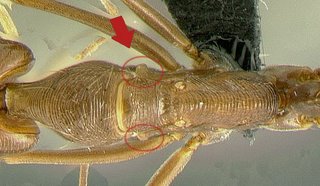Odontomachus
Yesterday I went to Harvard to look at some of my ants and have lunch with David Donoso, who was here for a few weeks on an Ernst Mayr Grant. I met David when I was in Ecuador and he was a student at Pontificia Universidad Católica del Ecuador. He is now preparing to start grad school under Mike Kaspari, and no doubt has a glorious career ahead of him. As glorious as a career in myrmecology can be, I suppose.
After lunch I took a look at my Odontomachus, which I had previously identified but for some reason became unsure about at some point. So I looked at all of them over again and was able reconfirm all of the previous species. Some interesting notes:
I have identified O. yucatecus which seems to only occur on the Yucatan peninsula. But the characteristic -- longitudinal striation on mesonotum vs. transverse striation -- seems pretty straightforward. I even got Stefan to double check for me. He agreed that it looked like yucatecus, and that the minor differences can be attributed to geographical variation. So that is pretty exciting to have found it so much further south.
I also identified O. panamensis. According to Jack Longino's site, panamensis has only ever been found in Costa Rica and Panama, so I thought my specimens were pretty special but further investigation reveals that panamensis has since been found in Brazil and Colombia (see Fernandez and Sendoya, 2004). Not Ecuador, though, so they are still special, just not as cool as I thought.
I learned that O. meinerti can have queens where the mesonotum is longitudinally striate even though the workers are always transversely striate. Good to know. Also the workers vary greatly in size and color. Also good to know. I also learned that O. meinerti is the same thing as O. minutus. O. minutus appears in Brown, 1976, which contains the key I use, and when going through the MCZ's collection, there are specimens labelled minutus, but not meinerti. In addition, there are many publications which refer to minutus, but when I searched on the Hymenoptera name server, there was no mention of Odontomachus minutus. Instead, they have a reference to Odontomachus haematoda subsp. minuta, which I think is supposed to be the same thing, but was fairly difficult for me to figure out. All of which was very confusing. I've got it now, though. O. minutus = O. meinerti. End of story.
 O. mayi can be identified by the mesipisternal anteroventral lobes that protrude very obviously when viewed dorsally. These lobes exist on the reproductives but are much less obvious. This is a picture of a worker.
O. mayi can be identified by the mesipisternal anteroventral lobes that protrude very obviously when viewed dorsally. These lobes exist on the reproductives but are much less obvious. This is a picture of a worker.
So that's about it for Odontomachus. I have a few extra specimens I still need to look at, but I hope to do that next week.
After lunch I took a look at my Odontomachus, which I had previously identified but for some reason became unsure about at some point. So I looked at all of them over again and was able reconfirm all of the previous species. Some interesting notes:
I have identified O. yucatecus which seems to only occur on the Yucatan peninsula. But the characteristic -- longitudinal striation on mesonotum vs. transverse striation -- seems pretty straightforward. I even got Stefan to double check for me. He agreed that it looked like yucatecus, and that the minor differences can be attributed to geographical variation. So that is pretty exciting to have found it so much further south.
I also identified O. panamensis. According to Jack Longino's site, panamensis has only ever been found in Costa Rica and Panama, so I thought my specimens were pretty special but further investigation reveals that panamensis has since been found in Brazil and Colombia (see Fernandez and Sendoya, 2004). Not Ecuador, though, so they are still special, just not as cool as I thought.
I learned that O. meinerti can have queens where the mesonotum is longitudinally striate even though the workers are always transversely striate. Good to know. Also the workers vary greatly in size and color. Also good to know. I also learned that O. meinerti is the same thing as O. minutus. O. minutus appears in Brown, 1976, which contains the key I use, and when going through the MCZ's collection, there are specimens labelled minutus, but not meinerti. In addition, there are many publications which refer to minutus, but when I searched on the Hymenoptera name server, there was no mention of Odontomachus minutus. Instead, they have a reference to Odontomachus haematoda subsp. minuta, which I think is supposed to be the same thing, but was fairly difficult for me to figure out. All of which was very confusing. I've got it now, though. O. minutus = O. meinerti. End of story.
 O. mayi can be identified by the mesipisternal anteroventral lobes that protrude very obviously when viewed dorsally. These lobes exist on the reproductives but are much less obvious. This is a picture of a worker.
O. mayi can be identified by the mesipisternal anteroventral lobes that protrude very obviously when viewed dorsally. These lobes exist on the reproductives but are much less obvious. This is a picture of a worker.So that's about it for Odontomachus. I have a few extra specimens I still need to look at, but I hope to do that next week.


No comments:
Post a Comment